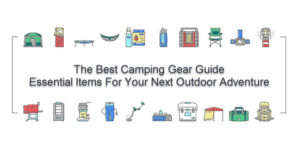Whether you’re a seasoned camper or just starting out, cooking in the great outdoors can be both challenging and rewarding. From choosing the right camping stove to selecting the perfect pot for your meal, there are many factors that come into play when it comes to camp cooking. In this blog post, we will cover everything you need to know about essential camping gear for cooking on your next adventure.
Introduction to Camp Cooking
Before we dive into specifics, let’s take a moment to discuss what makes good camp cooking. First and foremost, safety is key! Make sure all of your equipment is in good working order before leaving home, and always follow safe cooking practices while in the wilderness. This includes keeping flames away from flammable materials like tents and trees, as well as being mindful of hot surfaces and liquids. Additionally, consider how much food you plan to prepare and pack accordingly so as not to overload yourself with heavy gear. Finally, don’t forget to bring along any necessary utensils and condiments to make your meals complete.
Essential Camping Stoves
When it comes to cooking in the wild, having a reliable source of heat is crucial. There are several types of camping stoves available, each with its own unique benefits and drawbacks. Some popular options include gas-powered stoves, liquid fuel stoves (such as white gas), and solid fuel stoves (like propane). Gas-powered stoves tend to be lightweight and easy to use, but may require refilling mid-trip. Liquid fuel stoves offer a longer burn time than gas, but require more prep work and can be messy. Solid fuel stoves are durable and simple to operate, but can be heavier than other options. Ultimately, the best choice depends on personal preference and intended usage.
Choosing the Right Pots and Pans for Camping
Once you have chosen your camping stove, it’s time to select the proper pots and pans for cooking. The type of pot you choose should depend on the size of your group and the type of food you plan to prepare. For smaller groups, a single pot or skillet should suffice, while larger groups may benefit from multiple pots and pans. When it comes to material, metal pots tend to conduct heat better than plastic ones, making them ideal for high-heat applications such as boiling water. However, they can also be heavier and less flexible than their plastic counterparts. Plastic pots are lighter weight and easier to clean, but may not hold up as well under extreme conditions. Whatever option you choose, make sure it has a secure lid to prevent spillage during transportation.
Portable Grills: The Ultimate Campfire Accessory
For those who prefer their meat grilled rather than stewed, portable grills are an excellent addition to any camp kitchen. These compact grills are designed to fit onto most campfires and provide ample space for cooking burgers, dogs, and even fish. Many models feature foldable legs for easy storage and transport, as well as built-in stands to keep food off the ground. While some grills rely on charcoal for heat, others utilize electricity or propane. Regardless of which method you choose, remember to never leave a fire unattended and always extinguish completely once cooled.


